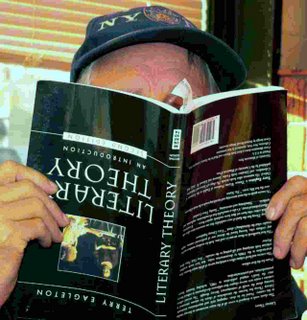Books on Sale: Realities Regarding the Style of the Pile
Everybody who's worked in a library, or a reading room, or even in a student or clinic lounge (with a stack of magazines) knows that the stock of reading matter will end up messed up, left on chairs, and probably damaged and soiled if some staff person does not periodically pick up after the readers and browsers of titles.
The same thing is doubly true of bookstores.
Discussing specific examples should be fun. I would like to hear from others.
SIDEBAR ABOUT COMMENTS
(The post below is long -- on other blogs I sometimes skip longish content and go straight to the COMMENTS to check out reader reactions. But C.P.E. is new, so we don't have many commenters reacting. Not yet. So feel encouraged, even before reading the text, to check out all the comments left on any post so far and then post your own comments as well.)*
*Three people I visited lately, and who prefer computer-based activity to watching television, have already started reading this blog. But only one of them has posted a comment. Why not? It comes down to their trepidation when faced with interactions on the Internet. So, while I would love to jump into a dialogue with everybody about topics like the messiness us locals in Montreal face at the MCC bookstore in our community, I also recognise that C.P.E. must also bring our 'connected' neighbours along to familiarise them with blogging, and particularly with the COMMENTS feature -- then prod them to converse with us.
So, to encourage everyone reading C.P.E. to leave comments, we must tell you from the top what it entails. We need to make it easy. To this end, I've enabled 'Anonymous Commenting' -- you do not need to sign your remarks, nor fill out a form or profile statement before having your say. This morning, I also turned off the 'Moderate Comments' feature so that everyone who comments will see them posted right away. I have also identified and downloaded documents to post here from time to time that explain blogs and blogging and which provide a few tips to make the experience of participation more accessible.
If you leave a comment here, I do not have a way of discovering your true identity. If you register with Blogger (which is associated with Google), the username you choose and the profile for your ID will not give away your identity you when you log onto any personal blog or commercial site. On some blogs, the host can see your computer's IP (Internet Protocol) address - depending on the configuration of your connection to the Internet. But this info is of little interest to most website managers and is of no interest to me -- I have no way to even see your IP address.
Do not fret if the above is not clearer than mud to you. I will be posting short blog user guides as we go along. The point is one of transparency and clarity. You remain as anonymous as you like on Cheap Priceless Editions.
END SIDEBAR ON COMMENTS
The "Style of the Book Pile": back to the topic at hand.
There is a Salvation Army, on rue Notre Dame, in Montreal, that goes back to a time out of mind. Time was when their bookshelves were as messy as the bins full of toys, household fixtures and winter outerwear. All that changed long ago.
Even the give-aways they sell are clearly organised on neat shelves as French or English, fiction or non-fiction, adult or childrens, as well as the many other categories (including paper and hardback, of course) that you can imagine. Once their sytem of care, shelving and maintenance was put in place, most of the titles were bumped up to higher sales prices. (Shortly thereafter - by total coincidence - the least tidy of the commercial used bookstores, on the edge of Old Montreal nearby the same crosstown street, burned to the ground. The other big old-style layback venue for neglected reading matter was sold and liquidated 5 or 6 years, after the owner died. Now only one of these palaces of bookstore chaos survives downtown (an English-language shop) and I happen to work part-time in the other messy bookstore surviving in the near-west suburbs.)
Even the tradition of the dollar and the quarter-cent book bin at the front of used bookstores is starting to die, giving way to more upscale digs and higher prices. But whatever the trend, used bookstores come and go, open and close, with regularity across town, English or French, Spanish too.
There is now a chain of secondhand stores in Montreal called Friperie Renaissance. Some of their outlets are like the old Salvation Army, some are like the new Sally Ann store, in terms of books. Again, those that are well managed have bigger selections, better organisation AND higher booktag prices.
I could tell you that I like one style more than the other. Sorry to be blunt, but this is a no-brainer. When I am a buyer, I want low prices. When I am a seller, I want high prices.
Up and to a point.
Stamp and coin collectors must certainly understand what I am about to convey. Sometimes a pile of dross is a pile of dross. Digging through the pile yields no jewel of discovery.
A well organised collection of books for sale, at higher (slightly higher) prices, in the low-end charity outlets, can be a boon for buyers. Even for the buy cheap, sell dear buyers. But here I am writing based upon firsthand experience and first principle: the books treated as dross in piles more often than not come out of the pile into the bookpickers basket as slightly or greatly 'hurt' (damaged) books. It is pure luck when you find a jewel in the rough that has not been roughed up. The roughest trade in used books is in a secondhand charity store where the rare item reaches CAN $5.99 and where the bulk of the Bell Curve (the majority) of print items fall into these price figures: 29, 49, 59 or 99 cents -- $1.99 for Harry Potter books and pop fiction still in fine 'wraps'. These are low, low prices for most titles.
I bought a softcover, oversized artbook about Frida Khalo for 59 cents there last week and sold it for $10 in my friend's bookstore yesterday. But, sadly, a corner was 'bumped' and in this case caused a corner to warp the pages, giving this graphic arts item a 'cocked' overall condition. But I did not have to elaborately describe the item to some online buyer and reduce the price asked in the offer: it was in an otherwise fine condition and the buyer was face-to-face with me, the seller, and I made my 2000% profit on it and they got a bargain over list price.
But try to find bargains like that in volume. No way! Neither on the finder's side nor on the closing the sale side of such an avaricious equation. Bump up the cost to the finder by a factor of 5, to a book in better condition at $2.99. Most times such a found item can be sold for no more than $20 or $25 if it is a fine arts image collection in oversize hardback (in today's market). And in the workingclass neighbourhood where I do most of my trading, it is only the occasional intellectual slumming it who will come down to our community bookstore venues and drop $25 for such a book (at half or one-third what it sells for in a museum boutique, by the way).
Okay. We are discussing low end marketing. But even the antiquarians are buying (at least at the big used book fairs) at the low end. And the lesson to be learned is that all along the channel, the stream and conduit for such books, booksellers have an economic and esthetic interest in the proper care and maintenance of the books being traded.
What many of us have found is that used books are so damaged by bookdealer neglect at the low-end that they end up in the garbage or are eventually pulped by Kruger Paper. In southern, southwestern and west-end Island of Montreal residencial districts, which includes an ethnically mixed population numbering some 200,000 souls, used bookstores come and go in a 4 to 10 year cycle. Look at the 'old' books now, the ones that survived the trade. (Many of the bookstores stamped their names on the first page endpapers.) You see a damaged book 9 times out of ten. Some of them show smoke damage (from fires or from an era of smoking in stores -- it's anyone's guess). So I conclude that a whole series of neglectful styles practised by a handful of bookstore owners I remember (and I could now name one or two who still survive in the trade -- though it is a disappearing breed) have inherited a constantly, physically deteriorating stock.
I know two co-operators of a used book boutique who are, slowly, turning the trend around. But they bought their stock from another careful bookseller. They will need to give away, trade or discard some of their stock as they bring in books in better condition. But the best books they find will be offered to their customers. This is unlike several other 'dealers', some without stores, who are saving their best in closed stacks and offering them through mega-vendors on the Internet. The ones who have bricks and mortar stores in this end of the local book market inevitably offer damaged, dirty and disorganized books stacked or jammed on shelves with the better books, willy-nilly.
Treasurer hunters beware. Where Internet sales pay the rent and low end bookstore practices prevail, the quality of stock either declines or the chance of making a Eureka find is reduced to near zero. All the books have been picked over to pull out the unique and valuable titles so that they can be squirreled away, ever ready to be shipped out from the basement of such a bookstore to an Internet / E-market buyer.
That is a continuing theme we must explore. Should we browse the net to find a book 24 hours before going into a used bookstore to buy? Sorta like ordering a pizza by email. But I promise to explain what I'm getting at here in another post.
Blogaulaire



No comments:
Post a Comment